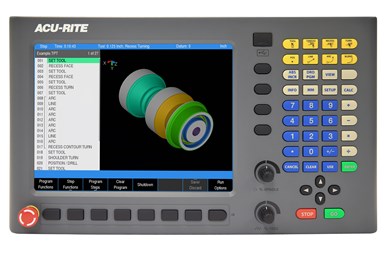Acu-Rite TurnPwr Control Enables Manual, Automated Lathe Operations
Appears in Print as: 'Lathe Control Enables Manual, Automated Operations'
It enables users to maximize throughput by significantly reducing setup time, scrap and other nonproductive operations, thereby increasing efficiency, productivity and profitability.
Edited by Angela Osborne

Acu-Rite TurnPwr Control
Acu-Rite’s TurnPwr control is a workshop-oriented turning control for lathes that enables users to program conventional machining operations right at the machine in an intuitive conversational programming language. It is designed for lathes with up to two axes.
TurnPwr was developed to offer lathe machinists both manual and automated operation where useful or needed. It enables users to maximize throughput by significantly reducing setup time, scrap and other nonproductive operations, thereby increasing efficiency, productivity and profitability.
The company says that the Acu-Rite conversational programming format for controls is a user-friendly method of writing part programs and included in the TurnPwr. However, G-code (ISO) programming can also be used and basic editing of G-code programs is also possible.
The control features a 12.1" high-resolution display boasting a screen layout that is clearly arranged. Preview graphics in the editor illustrate the individual machining steps for programming the contour as well as corresponding tool path generated, using only dimensions pulled from a production drawing. It also accepts DXF files.
TurnPwr is a closed-loop system with positioning feedback provided by rotary encoders inside the motor assemblies. When fitted with the (optional) Acu-Rite precision glass scales (1 µm/0.00005" resolution), TurnPwr also includes Position-Trac, an advanced feature that enables the user to easily, quickly and accurately reestablish workpiece zero after shutting down or power loss.
RELATED CONTENT
-
Monitoring Perishable Tools On Automatics
Monitoring tool wear is an essential component to getting greater productivity and lower costs from a machine tool.
-
A Fitting Machining Process
Diversified Fittings has turned to twin-turret/twin-spindle equipment and machine monitoring to become more efficient producing hydraulic fittings and adaptors.
-
5 Tips for Multichannel Programming
Programming for multitasking machines can be complex. Knowing several key points for making the process less challenging can save a programmer time as well as lessen confusion and the risk of error.



